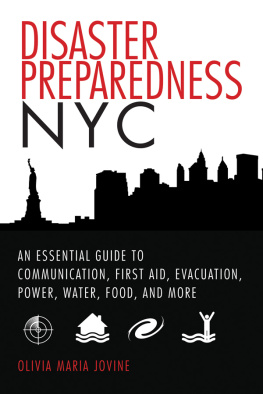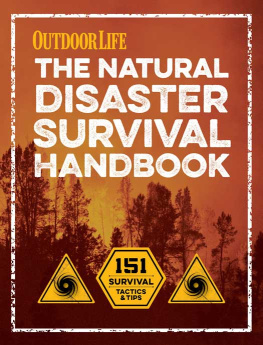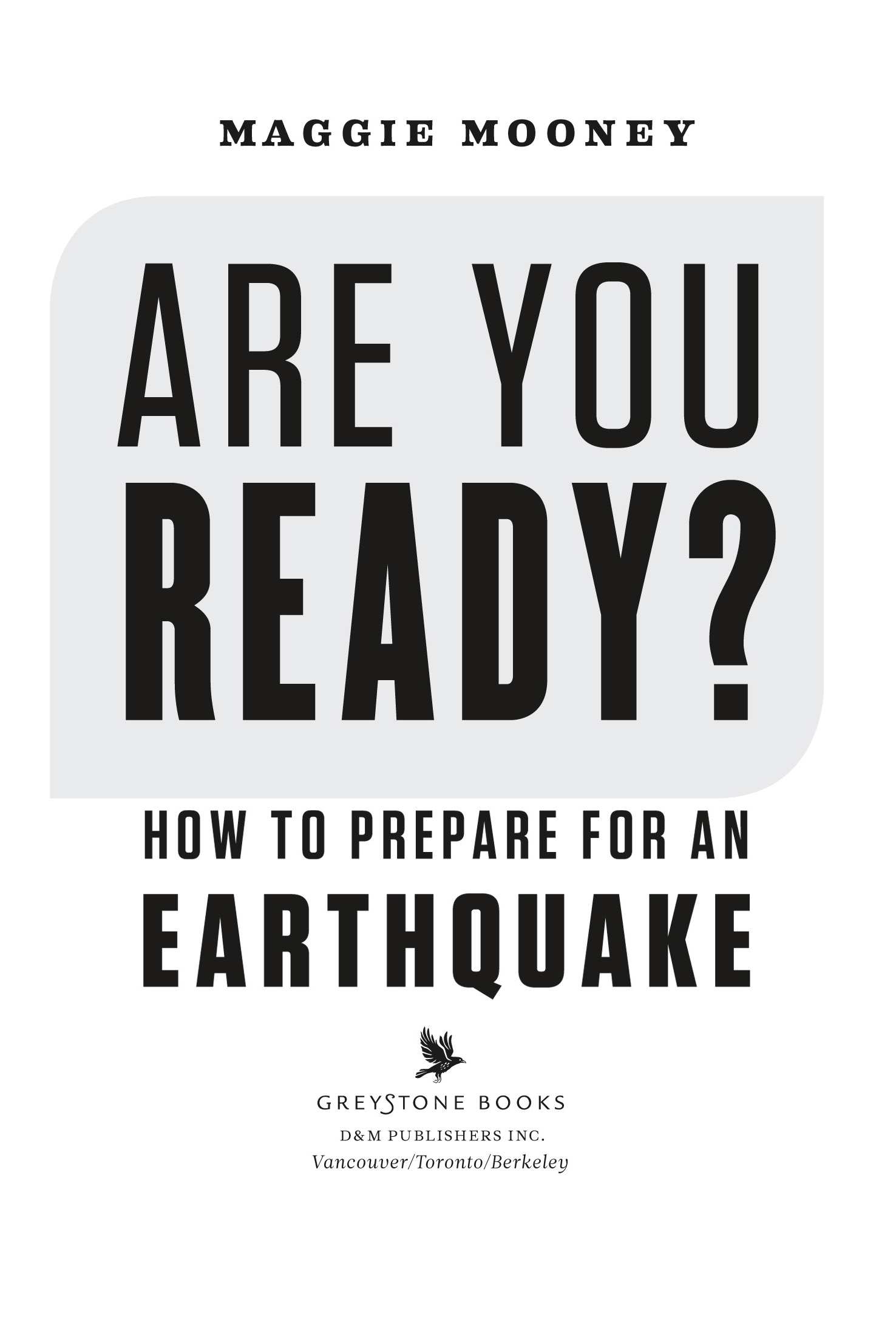THANKS TO Greystone Books for launching the project and in particular to Barbara Tomlin for her skilful editing. Barbara is a master of structure, and her respectful approach made the substantial reshaping of my writing much easier to take.
Thanks also to the books reviewers: John Clague of the Centre for Natural Hazard Research at Simon Fraser University in Vancouver, B.C. , and Teron Moore of Emergency Management British Columbia.
Gratitude also to my family and friendsmy sister, Katherine, for making my work in Vancouver possible; Janet Lironi for some helpful coaching; the Saturday morning Artworks coffee circle for care and laughter; and especially to Michelle Benjaminwhose generosity is vaster than that of anyone I knowfor her keen mind and sweet heart.
A COUPLE of years ago I moved to an island off the coast of British Columbia. I was eager (and a little anxious) to experience one of the multiple power outages the island has each year. The previous owners left us a list of suggestions for preparing for an outagehow to tell when one was likely to happen (fierce winds, snow, heavy rain) and what to do before (fill the bathtub with water) and during (report the outage to the appropriate people). By the third outage I was a proI knew the signs that it was time to fill the tub with water and felt better knowing the flashlights were stored in various spots and the wood box was full so that I could cook on the wood stove if necessary. I realized that we were living in a culture of preparedness, and that being unprepared would not only look foolish to our new neighbours but would cause some fairly significant inconveniences. I also realized how much this culture of preparedness readied me for an event very likely to strike my west coast home: an earthquake.
Scientists who have spent their lives studying major geological events are convinced that a massive earthquakethe Big Oneis imminent on the west coast of North America. And while the west coast is a seismically active area, earthquakes happen almost everywhere on our planet. The Earth is constantly moving in subtle and not-so-subtle ways. Recent events, including devastating earthquakes in Haiti, New Zealand, and Japan, have brought the threat of an earthquake to the forefront of our minds and raised our anxiety levels. But how many of us have actually responded by preparing ourselves for an earthquake happening close to where we live?
Earthquake expert John Clague watched the March 11, 2011, Japanese earthquake with keen interest. We cant predict when the next one will occur, says the Simon Fraser University professor. But, he continues, a seismic event is inevitable... We will experience one, and... this earthquake [in Japan] is a perfect analog for what we would expect to see on our coast.
If a major earthquake knocked out your power, disrupted your water supply, and damaged your home, could you cope on your own for three days or more? A major earthquake would inevitably overwhelm local fire, police, and emergency services. Damage to transportation infrastructure and communication networks might mean that getting help would take hours or even days. Receiving requested assistance from neighbouring cities might also take days or even weeks. Clearly, help will be in short supply.
Getting Ready to Get Ready
Are You Ready? is actually two books in one: an introduction to the science of earthquakes and an emergency preparedness guide. After considering the awe-inspiring power of earthquakes, we look at the psychological and practical preparation needed to respond. Psychological preparation is particularly important because we need to know what holds us back from preparing before an earthquake strikes and what we are likely to think, feel, and do during and after a quake. Earthquake preparedness is about more than gathering supplies. Disaster research is a vast and lively field, and much has been discovered about how peoplethe prepared and the unpreparedrespond. Understanding the psychological aspects of both anticipating and experiencing a life-threatening event will improve our ability to respond in an emergency.
The core of this book is a four-week readiness program that answers two important questions:
1. What are the minimum steps necessary to prepare for an earthquake?
2. How can busy people complete these most basic steps?
If you choose to follow this program, in week 1 youll create an emergency communication plan and begin to put together the supplies you will need. In week 2 youll identify and eliminate hazards from your home. In week 3 youll practise the essential actions that should become second nature for you and your family during an earthquake. And in week 4 youll look at safety issues involving your workplace and car. Youll also develop a plan for your pets if you need this.
In each week youll use the checklists and forms provided here to simplify preparation. If you are a parent or you work with children, you will want to look at the Tips for Children sections included in most chapters. If at the end of four weeks you would like to do some advanced preparation, you can use the information included about earthquake-proofing your home.
Of course, you might be like my friend Jesse, who says, Just give me the goods. Ive got two kids under the age of six and I work full-time. I have no time to prepare! Fine, I tell her, ignore the advanced preparation chapter and jump right past the science and psychology chapters to the four core readiness chapters. But the quick fix comes with a warning. The journey to the Land of Readiness is a tricky one. Many have travelled that route before and found themselves beached on the Isle of Procrastinationwith drawers full of maps and checklists, a half-filled emergency kit, and little understanding of what to do when an earthquake hits. Thats why this book includes a chapter on the psychology of preparing for and experiencing an earthquake. If you find yourself in a store, looking at bottles of water or first aid supplies, and the voice of that demon Anxiety whispers, Oh! This is kind of scary. Why are you doing this anyway? Preparing is for dummies/losers/survivalist nuts, and thenoverwhelmed by information, choices, and voicesyou run out of steam, please do yourself and your wee ones a favour. Go back and read the earthquake psychology chapter, and then return to the readiness program when youre done. Youll thank me for it.











